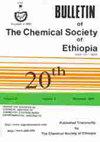一种新型偶氮喹啉配体及其金属配合物的合成、表征、分光光度测定及其Hg(II)配合物的生物功效研究
IF 1.3
4区 化学
Q3 CHEMISTRY, MULTIDISCIPLINARY
引用次数: 1
摘要
摘要采用4-碘苯胺重氮盐与8-羟基喹啉偶联反应,合成了偶氮喹啉配体(E)-2-((4-碘苯基)二氮基)-8-羟基喹啉(IPDHQ)。采用紫外可见分光光度、红外光谱、质谱、核磁共振、磁灵敏度和摩尔电导率等方法对合成的配体及其Cd(II)、Pd(II)、Cu(II)和Hg(II)配合物进行了表征。Cd(II)、Cu(II)和Hg(II)配合物的通式为[M(L)2]. cl2。而Pd(II)配合物的通式为[M(L). cl2]。H2O与方形平面几何。以合成的配体为分光光度试剂,建立了一种简单、快速的测定汞(II)的分光光度法。通过测定所得橙色配合物在430 nm处的吸光度,线性范围为0.5 ~ 15µg mL-1,并对其干扰效应进行了研究。合成的偶氮配体及其Hg(Ⅱ)配合物对四种细菌的生物活性进行了测试。 关键词:偶氮喹啉配体,8-羟基喹啉,4-碘苯胺,偶氮金属配合物,分光光度法测定,生物功效研究;公牛。化学。Soc。中国生物医学工程学报,2016,37(6),1459-1470。DOI: https://dx.doi.org/10.4314/bcse.v37i6.13本文章由计算机程序翻译,如有差异,请以英文原文为准。
Synthesis and characterization of a new azo quinoline ligand and its metal complexes with spectrophotometric determination and biological efficacy study of its Hg(II) complex
ABSTRACT. An azo quinoline ligand, (E)-2-((4-iodophenyl)diazenyl)-8-hydroxyquinoline (IPDHQ), was synthesized by the coupling reaction of 4-iodoaniline diazonium salt with 8-hydroxyquinoline. The synthesized ligand and its Cd(II), Pd(II), Cu(II) and Hg(II) complexes were spectrally characterized by UV‒Vis spectrophotometry, FT-IR, mass spectral analysis, 1H-NMR, magnetic sensitivity and molar conductivity. The general formula of the Cd(II), Cu(II) and Hg(II) complexes is [M(L)2].Cl2.H2O with octahedral geometry, while the general formula of the Pd(II) complex is [M(L).Cl2].H2O with square planer geometry. A simple and rapid spectrophotometric procedure was suggested for the determination of Hg(II) using the synthesized ligand as a spectrophotometric reagent. By measuring the absorbance for the resulting orange complex at 430 nm, the linearity range was 0.5-15 µg mL-1, and the interfering effect was also studied. The synthesized azo ligand and its Hg(Ⅱ) complex were tested for their biological activity against four bacterial strains.
KEY WORDS: Azo quinoline ligand, 8-Hydroxy quinoline, 4-Iodoaniline, Azo metal complexes, Spectrophotometric determination, Biological efficacy study
Bull. Chem. Soc. Ethiop. 2023, 37(6), 1459-1470. DOI: https://dx.doi.org/10.4314/bcse.v37i6.13
求助全文
通过发布文献求助,成功后即可免费获取论文全文。
去求助
来源期刊
CiteScore
2.20
自引率
8.30%
发文量
113
审稿时长
6-12 weeks
期刊介绍:
The Bulletin of the Chemical Society of Ethiopia (BCSE) is a triannual publication of the Chemical Society of Ethiopia. The BCSE is an open access and peer reviewed journal. The BCSE invites contributions in any field of basic and applied chemistry.

 求助内容:
求助内容: 应助结果提醒方式:
应助结果提醒方式:


